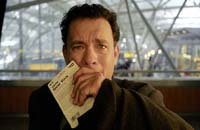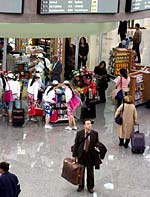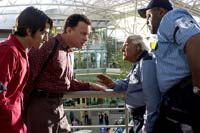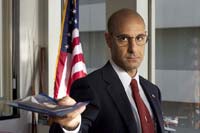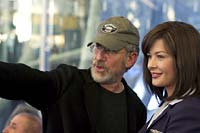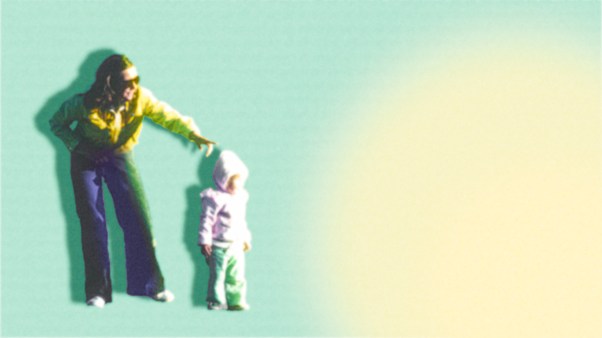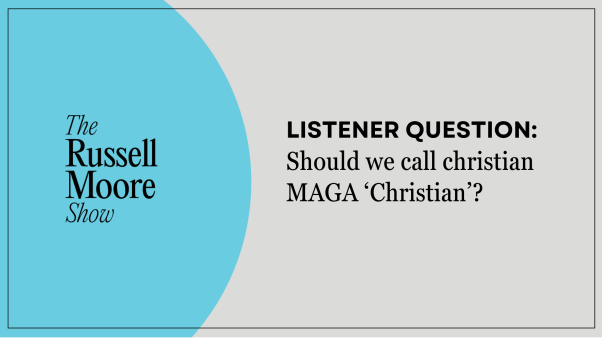Near the end of Steven Spielberg’s new film The Terminal—an ambitious, whimsical and sentimental movie similar in tone and gloss to 2001’s Catch Me If You Can—one of the characters proves to be quite a juggler. It’s a delightful moment, primarily because we know we aren’t watching a special effect. That guy’s really juggling those hoops and spinning those plates! Likewise, Spielberg’s film is a juggling act that keeps the audience enthralled with small wonders and dramatic crescendos, even though he drops several of the hoops he’s tossed, and some of the ideas spin out of control and crash to the floor in a cacophony of Hollywood clichés.
The film plays out in a New York airport, which becomes the most exciting movie set Spielberg’s ever served up—a masterfully realized terminal constructed by production designer Alex McDowell. It’s a wonderland custom-made for master cinematographer Janusz Kaminski, providing him with a spectacular array of textures, details, and kaleidoscopic light. Packed with convincing crowds of extras, it’s a bustling microcosm of American life: capitalism, consumer anxiety, assaults of advertising, information overload, pagers, fast food, post-9/11 tension, and Frappucinos. Kiminski’s cameras acrobatically avoid the stampeding tourists, travelers, employees, security officials, and immigrants that clamber over each other in pursuit of tickets, souvenirs, information, sex, alcohol, a job … the works.
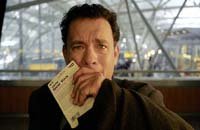
Spielberg drops Viktor Navorski (Tom Hanks) into the middle of this aquarium, a foreigner coming to New York on a secret mission—and then imprisons him there. In a scene of panic-inducing revelation, Navorski learns from the airport televisions that his (fictional) home country of Krakozhia has just descended into chaos, its government overthrown by a military coup. Since the U.S. can’t take any planes to this overturned nation, and since Krakozhian travelers are now people without a country, Navorski cannot be allowed to touch American soil. (The film is inspired by the true story of Merhan Nasseri, an Iranian refugee.) Navorski knows little English and has no American friends to come to his aid. He is stranded, stumbling around under the watchful eye of Frank Dixon (Stanley Tucci), the airport’s head Homeland Security officer. It reminds us of poor Truman Burbank’s life being monitored from a god’s-eye view in The Truman Show, and it should—The Terminal grew from a story by The Truman Show‘s Andrew Niccol.
Spielberg’s choice of Hanks was a no-brainer. Navorski is an amalgam of Hanks’ previous characters. Like a 12-year-old trapped in the body of a grownup (Big), Navorski’s trying to learn the manner, language, and codes of American society while maintaining some semblance of dignity and confidence. He’s striving to make sense of this insulated world just as Forrest Gump did his best to make sense of the great wide open. Like a man marooned on a desert island (Cast Away), he’s stranded and fighting for survival without the necessary resources at hand, alone in a wilderness, albeit a crowded one. (He keeps a sealed Planter’s peanuts can close at hand which contains a mysterious secret, not unlike that sealed FedEx box.) He’s even got that humble and virtuous look of the wrongfully mistreated that Hanks wore in Philadelphia.
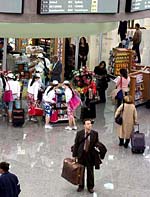
Taking on one staggeringly difficult role after another has turned Hanks into a sort of Hollywood stuntman. This has, unfortunately, worked against him. Viewers tend to walk away from his movies talking about the amazing feats of the actor instead of thinking about the character and the story. When I interviewed Michael Caine once, Caine insisted that if the audience is thinking about the actor, then the actor has failed. If the actor disappears into the character, and we forget about the performer, then he has succeeded. For the first few minutes of The Terminal, it’s hard not to be distracted by Hanks’ latest transformation. But thankfully, Spielberg and his screenwriters, Sacha Gervasi and Jeff Nathanson, give Navorski so much to do that we quickly get past thinking about that flawless Russian accent. They make him a three-dimensional human being. It’s Hanks’ finest performance yet.
If only the rest of the film were so believable. The Terminal reveals a great filmmaker aspiring to accomplish too many things in the space of two hours. Spielberg wants his film to be realistic, so he draws the tension tight as wire in scenes of complex cultural conflict. But a few moments later, he tries to make us swoon into a scene sticky with Hollywood syrup. It’s the same problem that plagued Frank Darabont’s Shawshank Redemption. Is it hard-hitting realism and cultural commentary? Or is it an emotional fairy tale?
This fractured style becomes most obvious in scenes involving two primary characters: a one-dimensional villain and a love interest that could only exist in a movie.
Just as the warden in Shawshank was a comic-bookish caricature oppressing a prison full of human beings, so Frank Dixon oppresses Navorski. Sure, it’s reasonable to believe that Navorski would cause Dixon some stress. But every time we see this government goon, he’s agonizing over his Krakhozian prisoner as if it’s his full-time job. One wonders why he never bothers to find a translator, but merely lets Navorski dog paddle his way around the airport for months. (It’s also mind-boggling that Navorski himself never bumps into someone who can console him in his own language. It’s a New York airport!) By the end, Dixon’s so hysterical in his attempts to spoil Navorski’s happiness, we wonder if he’s about to have a psychotic episode. If we had seen him spending more time at his job, or caught glimpses of his life outside the Navorski plot, he might have been convincing. Instead, he becomes an unfair representation of the Americans fighting hard to make our airports safe and our nation terrorist-free.
As Amelia, Navorski’s inevitable love interest, Catherine Zeta-Jones is somehow transformed, looking younger and spunkier than ever. But she’s also burdened with awkward dialogue that’s as artificial as any Hollywood-brand sweet nothings in recent memory. She’s as manufactured as the models posing in the glamour ads throughout the terminal.
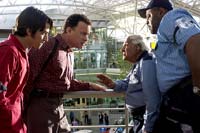
The rest of the cast is populated with an amusing crew of culturally diverse airport employees, the most colorful array of actors Spielberg’s ever assembled. They include Ray the sympathetic customs officer (Barry Shabaka Henley), Enrique the food service employee (Y Tu Mamá También‘s Diego Luna), and a baggage handler named Joe (Chi McBride) who likes to play poker for prizes from the airport lost and found. Best of all, there’s the janitor Gupta, played by Kumar Pallana in his biggest and most memorable role.
Each of the supporting characters provide Navorski with episodic opportunities to demonstrate his resourcefulness and virtue. But the film isn’t really about being a virtuous man. Nor is it about immigration, national security, or true love. The Terminal is so ambitiously busy, distracted by its own dizzying environment, it can’t quite figure out which themes should be prominent.
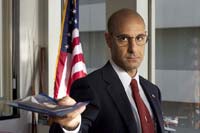
It effectively illustrates the difficulties of American immigrants, struggling to find a life in a competitive and complicated society. It also summarizes the modern, fast-paced, technology-saturated lives that Americans spend in pursuit of happiness, assaulted from all sides by the false promises of commercialism, running from one vendor to the next for another quick fix. In its love story, The Terminal suggests that we can ruin ourselves by settling for unhealthy affairs instead of holding still to enjoy the rewards of the real thing. What we really want, Amelia learns, is a true love who will be there for us, waiting faithfully, when and where we need them. Then there’s the eloquent imagery of Navorski himself being processed by the luggage-scanner, or being preyed upon by airport security cameras—powerful visual metaphors for just how little we can learn about the human heart with our modern methods of detection. When we start off suspicious of each other, Spielberg suggests, we inevitably arrive at false and damaging judgments.
Perhaps the most recurring motif is the question, “What are you waiting for?” Some wait for delayed flights. Some work tedious jobs for long years, holding out for that “pot of gold” in retirement. Others wait for true love to grow in a place where it shouldn’t. Meanwhile, while Victor waits to go home, he finds ways to invest his time, use his talents, and form some fruitful relationships. He may be waiting, but he’s also living, demonstrating the redemptive power of the imagination in the face of hardship.

But the fault lines of Spielberg’s fractured style divide these stories into incongruous subplots. Some scenes are subtle and affecting, followed by others that spell out simple sermons in large capital letters so nobody misses the point. For all of his profound observations, Spielberg is unable to carry all of these themes to a satisfying finish. The Terminal is a cinematic jazz piece that boasts flourishes of masterful musicianship, but it never coheres into a convincing and satisfying whole.
The film concludes with a ten-car pile-up of sentimental resolutions. And before it’s over, that Mystery Can turns into a jack-in-the-box, out of which pops a conclusion that would have been much more resonant had we learned its secrets earlier. What could have been Spielberg’s most graceful conclusion—a delightful musical interlude—is abruptly abandoned for a tacked-on, predictable send-off. Once upon a time, in a film called Close Encounters of the Third Kind, Spielberg trusted the power of music to bring profound closure and leave us with a sense of possibility and awe. For a fleeting moment in The Terminal, it appears he will do that again. But the moment ends abruptly in favor of a much more predictable sendoff. Whether or not Navorski ever escapes this insular kingdom of consumerism and gets to walk the streets of the real world, at the conclusion of The Terminal we know we’re still stuck in the terminal of Spielberg’s sentimentalism.
Talk About It
Discussion starters- Do you think the increased security efforts at our airports and borders are going too far? Are they not going far enough?
- One of the characters suggests, “Sometimes you’ve got to stop thinking about the rules and concentrate on the person.” Is that a good philosophy? Should Dixon have let Navorski go in spite of the rules? Can you think of other things he might have done to help Navorski out?
- What do you think of the ways that Navorski chooses to spend his time in the airport? Is he using his time well?
- Look at each major character: What is important to him/her? What are they “waiting for”? Are they seeking satisfaction from the right places/things/people?
The Family Corner
For parents to considerThe Terminal is rated PG-13 for mild sexual references, drug references, and some foul language. But it also raises ethical questions about the law, about relationships, and about being a responsible employee. There is much here for parents to discuss with teenagers, but the film is inappropriate for younger viewers and much of it would probably go over their heads anyway.
Photos © Copyright DreamWorks
What Other Critics Are Saying
compiled by Jeffrey Overstreetfrom Film Forum, 06/24/04“Just call him Foreign Gump,” writes Bob Smithouser (Plugged In) about Viktor Navorski in his review of Steven Spielberg’s new film The Terminal.
And he’s right. The central character of this whimsical, inventive comedy is played by Tom Hanks and bears a striking resemblance to Mr. Gump in the way he brings a simple, good-natured wisdom to those he encounters during his long, long stay in New York’s JFK airport. Hanks plays Viktor Navorski, a man from the imaginary nation of Krakhozia who, upon his arrival in the Big Apple, learns that his country has fallen into violent political turmoil. The Department of Homeland Security officer at JFK (Stanley Tucci) informs Viktor that it is illegal for him to set foot on American soil, and worse, he can’t go home until Krakhozia stabilizes.
So Viktor, who knows only a few words of English, is forced to live on limited resources (echoing another Hanks film—Cast Away), required to wrestle with an unfair and insensitive superior (echoing another Hanks film—Philadelphia), and driven to learn about a large and confusing world that is far from anything he’s experienced before (echoing, yes, Hanks’ classic comedy Big). Before it’s over, Navorski will get a grasp of the language, find ways to earn some lunch money, transform an out-of-service flight gate into a home, fall for a beautiful flight attendant (Catherine Zeta-Jones), befriend a team of airport workers of all colors and sizes (Chi McBride, Diego Luna, and Wes Anderson’s favorite supporting actor, Kumar Pallana), and learn to dodge the dispiriting obstacles thrown into his path.
In his review, Smithouser concludes that the “triumphant good-man-against-the-system element is the best part of this touching, poignant, often funny film. Intriguing people. Unusual circumstances. Inspirational moments. Not a bad place to spend a couple of hours. As always, Hanks is terrific.”
But there are some problems in the film that bother many of the film’s critics (including me). The fault lines of Spielberg’s fractured style divide the film’s multiple storylines into incongruous subplots. Some scenes are subtle and affecting, followed by others that spell out simple sermons in large capital letters so nobody misses the point. In Spielberg’s multi-genre repertoire, this a cinematic jazz piece that boasts flourishes of masterful musicianship, but, unlike Spielberg’s last film, Catch Me If You Can, it never coheres into a convincing and satisfying whole. Despite what may be Hanks’s finest performance, The Terminal is like a sentimental, superficial, Hollywood movie that has strapped itself to a hard-hitting cultural commentary and entered a three-legged race—it proceeds at a stumbling, awkward pace and collapses before it reaches its goal.
My full review is at Christianity Today Movies.
David DiCerto (Catholic News Service) says its “weak script and lackluster performances keep viewers’ attention in a holding pattern. Still, [the movie] is not without some uplifting moments. Harkening back to an old-fashioned Hollywood hopefulness, the movie is built around a Capraesque belief in the goodness and decency of humanity. For the most part, however, The Terminal is just that—terminal.”
Steven D. Greydanus (Decent Films) says Hanks is “funnier than he’s been in a long time.” But he concludes, “The story wobbles between plotlines and characters that make emotional sense and ones that don’t. And the climax … is pretty much unsalvageable. In Spielberg and Hanks’s professional hands the whole package remains passably entertaining, but much of it doesn’t bear thinking about afterwards—not because the premise is implausible, but because, granted the premise, characters do things that no one would, or should, do under those circumstances.”
Megan Basham (CBN) writes, “The Terminal is for the most part everything one would expect—charming, funny, possessing of its own singular character and visual beauty. But what it is not is intellectually honest.”
Annabelle Robertson (Crosswalk) raves about it. “Funny without being slapstick, heartwarming without being sentimental, inspiring without being preachy, it is the most uplifting film I’ve seen in a long time.”
Michael Elliott (Movie Parables) says, “Hanks is very amusing. Stanley Tucci is perfectly cast. The scenes between Hanks and Tucci are well-timed and brilliantly executed.” But he adds, “The romantic relationship between the characters doesn’t work for me and is a subplot that distracts from the more interesting element of the film.”
Michael Medved (Eye on Entertainment) says it’s “full of rich humor and emotional rewards, but hurt by an ambiguous ending and plausibility problems.”
Mainstream critics have plenty of criticism, but most end up clearing the movie for takeoff.
from Film Forum, 07/29/04Reviewing Steven Spielberg’s The Terminal, a blogger at World says the film’s “as long as a post-9/11 security check,” and goes on to sum up its purpose: “To paint the current administration as soul-sapping, totalitarian hypocrites who use technology, technicalities and treachery not to increase security but to feed its image and ambition. Every move is watched by the incessant electric eye of Big Brother … . Illegal activity is halted or allowed as it serves the government’s immediate purposes. Only immigrants and minorities are portrayed sympathetically. As Steven Spielberg films often do, The Terminal reaches a supposedly redeeming end—but it’s as satisfying as the cracker and condiment sandwiches Victor resorts to for survival.”
Copyright © 2004 Christianity Today. Click for reprint information.

